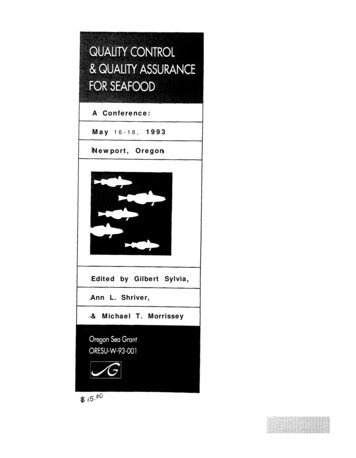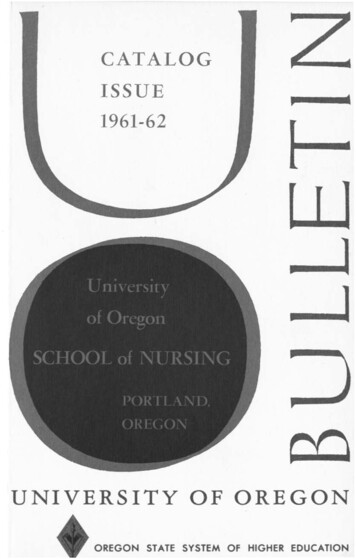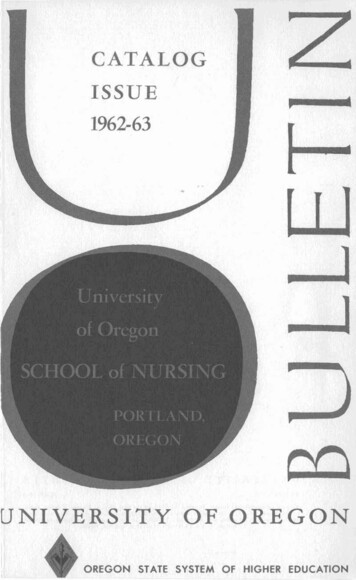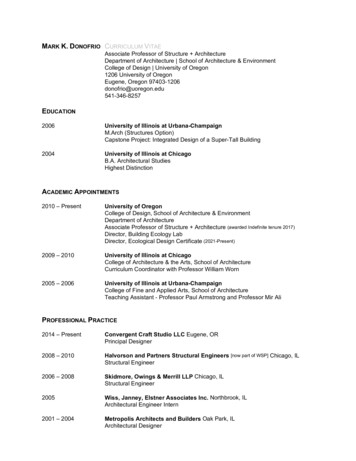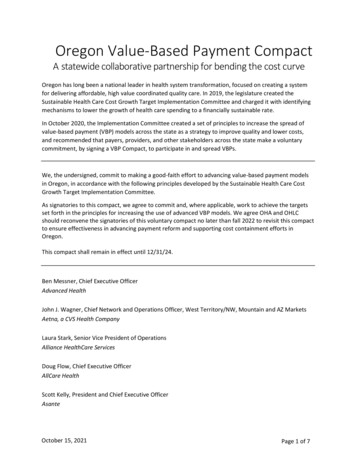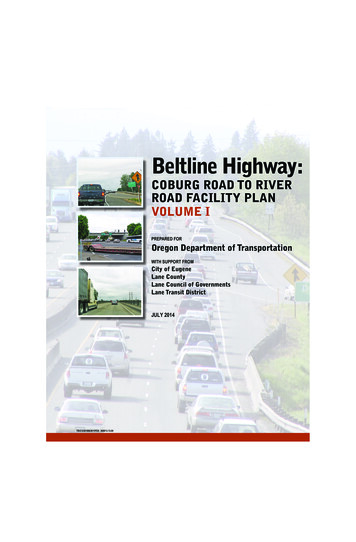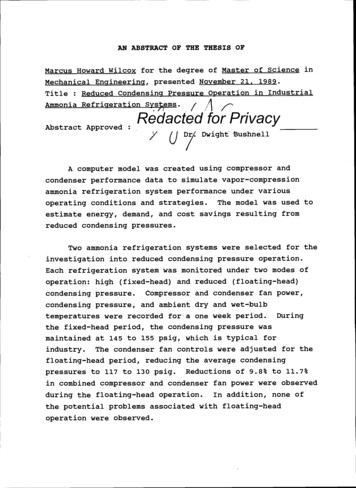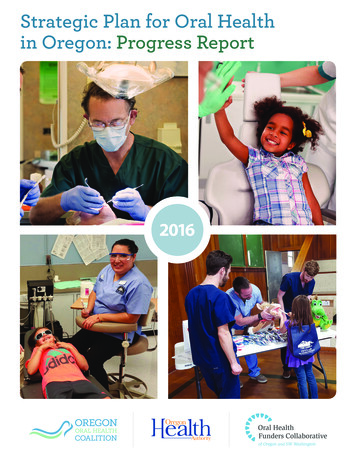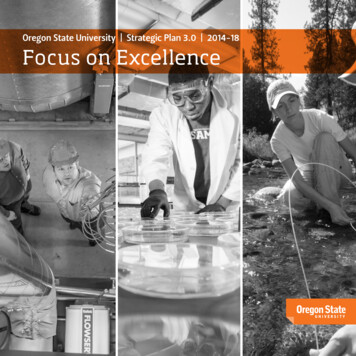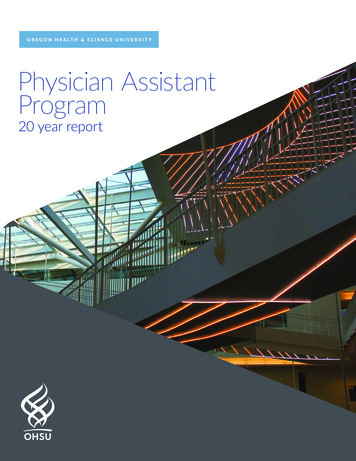
Transcription
O R E G O N H E A LT H & S C I E N C E U N I V E R S I T YPhysician AssistantProgram20 year report
23Letter from Ted RubackTed Ruback, founding OHSU PA Program Director, atthe 20th anniversary event.Alumni enjoying the celebration.On August 12, 2016, the OHSU Physician AssistantProgram held its first-ever alumni reunion to celebratethe 20th anniversary of the program. The celebrationrecognized the many accomplishments of the program,most significantly, the 576 graduates who have joined theranks of the PA profession since the program’s inception.It was a wonderful evening, attended by more than 100alumni, as well as members of the faculty and staff,family and friends.The event included tours of the Collaborative Life SciencesBuilding, located on Portland’s South Waterfront; the newhome of the program. Most importantly, the evening gavepeople a chance to reconnect with old friends, classmates,faculty and staff. One attendee put it best when he told me,“I haven’t seen most of these folks for many years, and yetwe sat down together for dinner and we easily just startedwhere we left off.”A heartfelt shout-out was given to the inaugural Class of1997, for having 11 of its 12 graduates in attendance. Infact, almost 20 percent of our grads attended.As the evening progressed, I had the opportunity tointroduce everyone to the current faculty and staffof the program starting with my co-founders, ColleenSchierholtz and Pat Kenney-Moore. It was a delight for meto publicly acknowledge Colleen and Pat for their pivotalrole in the development, implementation and initial, aswell as ongoing, success of the program.Colleen was my first hire as program director. Mostgraduates will fondly remember Colleen as the firstperson with whom they interacted. All students andgraduates are well aware of how highly I value theGraduates, friends, family, faculty and staff at the20-year celebration held at the Collaborative LifeSciences Building.www.ohsu.eduprocess of admissions in maintaining the qualityof our program and our profession. From thebeginning, Colleen shared that value with meand, as director of admissions, she contributedto the success of our program by ensuringand maintaining a fair and deliberateadmissions process.Pat Kenney-Moore joined Colleen and me in Aprilof 1995, five months before the matriculation of thefirst class. As academic coordinator, Pat workedclosely with me in the design and implementationof the didactic curriculum. In 1999, I had thepleasure of promoting Pat to the position ofassociate director of the program. In her dualrole, Pat has remained a loyal, reliable and valuedpartner in the leadership of the program.Pat is recognized as a master teacher. She is laudedby faculty and students for her clear, organized andengaging instruction. She consistently adheres tovery high standards while supporting students intheir efforts to meet those standards. There is nostronger student advocate than Pat.Colleen, Pat and I have remained loyal andcommitted partners in our efforts to optimizethe success of our program and our graduates.I owe them both a great debt of gratitude for theirfriendship and dedication throughout the morethan twenty years we have worked together.I will always be thankful for the wonderful teamof creative, talented and devoted people I had theprivilege of working with during my tenure.In the summer of 2015, after nearly 22 years,I decided that it was time for me to step down asprogram director. Although difficult, the decisionwas the right one for both me and the program.I came to OHSU in 1994, charged with developingand implementing the first PA Program inthe state. I believed that with the support andresources available to me at OHSU, we couldcreate a challenging and academically rigorousprogram that would rival any of the longestablished and well-respected PA programs inthe country at the time.The selection of the first class was challenging.The first application cycle attracted more than 200applications for 14 seats. I will always be beholdento the inaugural class for their trust and belief inme and their contribution to the creation of theOHSU PA Program.Every student and graduate from that pointforward has contributed to the overall success andreputation of the program. Our first 19 classes ofgraduates have a 99.3 percent first-time pass rate onour national certification exam.Currently, our program is ranked fifth among PAprograms by U.S. News &World Report.The occasion of the 20th anniversary provides anopportunity for those of us who have dedicatedour careers to the success of the OHSU PhysicianAssistant Program, to celebrate its significantcontribution to the health care workforce. It’sa laudable achievement of which we are allexceedingly proud.OHSU PA Program’s ranking byU.S. News & World Report5TH20156T H20119TH1 59 PA2007Programs10 T H1 3 9 PA2003Programs1 3 4 PAPrograms19 6 PAPrograms
45The growth of aprofessionPhysician assistants play a vital role in health care. As expertsin general medicine, they work collaboratively with healthcare teams to provide patient-centered care. This care couldinclude obtaining medical histories, performing physicalexaminations, diagnosing and treating illnesses, orderingand interpreting lab tests, performing medical procedures,assisting in surgical operations, counseling patients onpreventive health and prescribing medications.The PA profession was created to expand access to health careand to improve and extend patient care. The profession hasgrown since its start in the mid-sixties when it began as acreative solution to a recognized shortage and maldistributionof primary-care physicians. This was at a time when veteranswith considerable medical training were returning frommilitary service.In 1965, Eugene A. Stead Jr. M.D., of Duke University MedicalCenter, selected four Navy Hospital Corpsmen to be the firstclass of PAs. After completing a curriculum based on the fasttrack training of doctors during World War II, the first classgraduated in 1967.The Oregon Society of Physician Assistants was incorporatedin 1982. In the early 1990s, the society along with the OregonOffice of Rural Health and other rural health constituencieslobbied for Senate Bill 607 which recognized that Oregon faceda shortage of primary care providers in rural areas and thatPAs could play a role in addressing this problem.The bill passed, and in 1991, the Oregon Office of RuralHealth was charged with studying the requirements andopportunities for establishing a physician assistant program inthe state. The resulting report supported creating a PA programin Oregon.In 1993, the Oregon Legislature awarded 150,000 in OregonState Lottery Funds to start the program and determined thatOHSU would be the most appropriate host institution.The OHSU Physician Assistant Program was established in 1995and graduated its first class in September 1997. In the springof 2001, the PA Program was recognized as a freestandingDivision within the School of Medicine.Class of 2017 students engaging in team-based learning in the CLSB classroom.www.ohsu.edu
67The OHSU PA Program currently ranks fifth among graduatelevel physician assistant programs in the nation according tothe 2015 rankings of the U.S. News & World Report.The inaugural class of 1997.On August 12, 2016, the program celebrated its20th anniversary.Here are some memories of and reflections on those twentyyears from three people who worked together to create andimplement Oregon’s first physician assistant program.The foundersTed J. Ruback, M.S., P.A.-C., was hired as the founding directorof the OHSU PA Program on October 1, 1994. He came to OHSUfrom the Emory University Physician Assistant Program wherehe was associate director and director of admissions.Our adopted classroom mascot.“My wife was born and raised in Washington State,” hesays. “We had met during my first year as a practicing PAin a small rural town in Central Washington. After 11years in Atlanta, we were both interested in returning tothe Northwest.”At the time, he notes, the number of PA programs in thecountry was growing in response to the increasing interest inthe profession. His experience as a program leader at Emorygave him the confidence to consider moving to the challengingrole of program director for a new PA program.The founders: Colleen Schierholtz, Ted Ruback, and PatKenney-Moore.www.ohsu.eduColleen Schierholtz was hired as an assistant to the directoron November 28, 1994. Colleen was promoted in 2001 to therole of director of admissions. She came to the program froma part-time position elsewhere at OHSU and remembersthat the PA program position attracted a competitive pool ofcandidates. “Once I was hired, I recall Ted was concernedabout whether or not I could commit to staying with theprogram for at least five years. He was looking to builda program and wanted to get the right people on board.Well, I guess he needn’t have worried about my long-termcommitment because here we are 21 years later.”Pat Kenney-Moore, Ed.D., P.A.-C., was hired as the academic coordinator for the PA Program on April1, 1995. She was promoted to the dual role of associate program director and academic coordinatorin 1999. Kenney-Moore moved to Oregon from Los Angeles where she had transitioned from full-timeclinical work in a primary care clinic to an academic role as an adjunct instructor at the Universityof Southern California Physician Assistant Program. Her role there included classroom teaching,curriculum and test development.“My commute was three hours a day, so I had plenty of time to contemplate opportunities that did notinvolve such a terrible drive! I saw a flier on the bulletin board outside my USC office space advertisinga new program starting in Oregon, and so I applied, never thinking I even had a chance. Aftertraveling to Oregon and interviewing with Ted I fell in love with the idea of helping to start somethingnew — and I was delighted and terrified to be offered the position of academic coordinator.”Building a rigorous student-centered programBy the time Ruback arrived in Oregon in 1994, the state’s Office of Rural Health had created a listof more than 1,600 potential applicants interested in enrolling in a baccalaureate-level physicianassistant program.With an increasing number of programs at the time moving to the master’s degree, it was his intent tostart the program as a graduate-level program, Ruback says, but with the high level of interest in anundergraduate degree, the program began at the baccalaureate level and was elevated to the master’sdegree in 2000.His goal was to “create a challenging program with a strong emphasis on basic and clinical sciencesthat would ensure our graduates would be well prepared to provide highly competent care totheir patients.”Because rural health constituencies played a key role in advocating for a PA program in Oregon,Ruback set goals for the program with their needs in mind. The program’s mission — to educateGrowth in applications to OHSU PA Program and changes in class size by year2000GRE waived1500APPLICANTSThe program is a 26-month, full-time course of study leadingto a Master of Physician Assistant Studies degree. The didacticphase of the program is 12 months; the clinical phase is14 months.1000Change to Master’s 93233362012363838CLASS SIZE BY GRADUATION YEAR20153839402018434242
89OHSU PA alumni practicephysician assistants to provide primary care services tounderserved populations, both rural and urban — has, he says,changed very little over time.about 27. This follows a national trend toward younger PA applicants. While students 20 years agotended to be on their second career, today’s students have often wanted to be a physician assistantsince high school. The profession, she says, has become more visible.For her part, Pat Kenney-Moore wanted to create earlyopportunities for students to get exposure to patients inhospital or clinic settings: “So that when they started theirclinical phase they could focus on applying the medicinerather than trying to figure out what to say and how to“At the start of this journey, I was one of only 600 licensed PAs in the state of Oregon. In the early years,we spent a lot of time educating people about the PA profession including the scope of practice and roleof the PA. While that work still isn’t done, we do find that there is an increased awareness of the PArole. I still find it necessary to explain my professional role on a fairly regular basis.”act. I am proud,” she adds, “to have had the opportunity tohelp transform what could be a competitive sink or swimexperience into a more humane, student-learningcentered experience.”Ruback, who has been a physician assistant for more than 37 years, agrees. While the role hascertainly expanded, he says, “there are still too many people who don’t know who we are or whatour role is in health care.41% P R I M A RY C A R E59 % S P E C I A LT YForty-one percent of OHSU PA alumni practice inprimary care. According to the National Commissionon Certification of Physician Assistants’ statisticalprofile released January 2017, 28 percent of PAsnationwide and 38.4 percent of Oregon PAs practicein primary care.OHSU PA alumni practice location23% RUR AL77% URBANTwenty-three percent of OHSU PA alumni in Oregonpractice in rural areas. According to the AmericanAcademy of Physician Assistants’ 2015 survey,12.9 percent of all Oregon PAs serve in rural areas.OHSU PA alumni contributionto the underserved19 % M E D I C A L LYUNDERSERVEDAREA/P O P U L AT I O NNineteen percent of OHSU PA alumni in Oregon workin medically underserved areas or with underservedpopulations. These are identified by the HealthResources and Service Administration as geographicareas and populations that lack access to primarycare services.www.ohsu.eduHer aims for the program are also informed by her interestin observing students’ mood and morale over the course ofthe program’s didactic year as they learn how to assume anew professional identity. “Living this intense experiencewith a new class of students each year reminds me of thechallenges that professional development programs presentto their participants.”“The scope of our practice has changed,” he continues, “and the scope and breadth of our educationhas changed along with it. Some programs early on were 12 months in length, the average programnow is 27 months.”Kenney-Moore anticipates that “there will be wonderful varied opportunities for our current andfuture graduates — they will find niches in areas of medicine far beyond the role that was originallyimagined for them when the profession was conceived by physicians in the 1960s.”Active OHSU PA graduates by state of practiceMy goal,” says Colleen Schierholtz, “was to contribute as muchas possible to the successful implementation of the program.”She had to reach out to the hundreds of people interested inbecoming physician assistants and to manage “the creation ofan application, a review process, an interview process, and afinal selection process.”74101027 9Kenney-Moore observes that the students, “have gottenyounger while I have gotten older!” The average student agein the program’s first class was 33. Today the average age is7534524221The program evolves along with the professionAs program director, says Ruback, “I have encouraged facultyand staff to share ideas and to suggest new approaches, evenwhen things were seemingly working well.” One example:three years ago, the program overhauled its highly successfulcurriculum. “Our teaching methodologies needed to changeto keep up with the expectations and learning experienceof a new generation of student,” says Ruback, explainingthat today’s students work in groups and employ technologyseamlessly in their learning processes. “The lecture-learnerformat is not their preferred method of learning.”241111115211312ALASK A26H AWA I I1GUAM1Fifty-five percent of OHSU PA alumni practice in Oregon. According to NCCPA, thereare 1454 PAs in Oregon. OHSU alumni represent 19 percent of practicing PAs in Oregon.
1011OHSU PA Program PANCE performanceA move to new facilities catalyzes change 9 9 %First Time Pass RateIn 2015, the PA Program moved from Gaines Hall on OHSU’s Marquam Hill Campus to its new home inthe Collaborative Life Sciences Building on the developing South Waterfront Campus.National Mean300400500600700800PA N C E S C O R E SAdvocating for the professionThe physician assistant profession is about to celebrate its 50th anniversary, says Ted Ruback, buthe is dismayed that occasionally he still has to explain himself to people who don’t know the role ofPAs in health care. “That’s the profession’s fault and something we all need to continue to focus on. Inour program, from day one, we teach students how important it is to explain yourself to patients andothers, to introduce yourself proudly and appropriately as a PA, an important member of the team inthe health care delivery system of today.”In 2001 the program was recognized as a freestanding Division within the School of Medicine. Thismeant that Ruback attended meetings of the clinical chairs of the School of Medicine. “My presenceclearly enhanced our visibility among the school’s leaders,” he says. Additionally, “it providedopportunities for me to advocate for and raise issues important to PAs practicing clinically on campusas well as issues important to the program.”Advocacy also happens at the state level. Kenney-Moore and Ruback have been active members ofthe Government Affairs Committee of the Oregon Society of Physician Assistants for nearly 20 years.They have supported legislation that allows PAs to practice to the full extent of their education andexperience. “I’m very proud of the advances we’ve achieved at the state level in improving the practicefor PAs in Oregon,” says Ruback.Over the course of their careers, many PAs practice in two or three specialty areas. A PA can switchfrom working in internal medicine, to, say, obstetrics and gynecology without getting additionaltraining. This gives them the flexibility to meet the changing needs of their patients, employersand communities.“It’s great to be part of such a growing, vibrant area. The mix of businesses and transportation, as wellas the educationally collaborative space where we work, is invigorating,” says Colleen Schierholtz.Staff and faculty from the PA Program now work down the hall from their counterparts in theSchool of Medicine, an arrangement that fosters the “sharing of our challenges, successes andcommon goals,” says Ruback.Additionally, the new classroom space, which faculty helped design, supports varied forms of teachingand learning. Since the move, there has been an integration of more learning techniques includinglecture, problem-based learning and team-based learning.The new patient assessment rooms are furnished just like clinic rooms so students can practiceskills in a realistic setting, says Kenney-Moore, who remembers the program’s old home in GainesHall with great fondness. Still, she says the new facilities are “nicer, more modern and provide newelectronic resources.”She feels that the move to the new facilities catalyzed change in both the M.D. and PA programcurricula. “Our new curriculum aligns content in clinical medicine, basic science, laboratory scienceand pharmacotherapeutics and allows us to have an integrated theme for each week.”Top specialties of practicing OHSU PA alumniFamily Medicine150Orthopedic Surgery65Internal Medicine36Emergency Medicine35Urgent nterology“This flexibility is what make us unique among health professions,” says Ruback. Recently, he says, theNational Commission on Certification of Physician Assistants has moved in the direction of recognitionof specialty credentials. Many in the profession feel, he says, that this trend runs counter to efforts tomaintain the profession’s valuable flexibility.Flexibility, “is the reason I chose to become a PA rather than going to medical school,” says KenneyMoore. “I have provided primary patient care services since becoming a PA 25 years ago, but if Iwanted to go into a different specialty tomorrow, I would be able to do so without being required tocompletely restart my cular Surgery10General Surgery10Endocrinology9Oncology8Critical Care6Otoloryngology6Pain Medicine6General Medicine5Geriatric Medicine5Ob Gyn5N T O TA L P R A C T I C I N G PA A L U M N I
1213The program has had a commitment to providing health care to rural Oregon since its inception, saysRuback. Two recent initiatives have strengthened and expanded this mission.In 2013, the Combined M.D.-PA Rural Rotation was developed by faculty from the School of Medicineand the Physician Assistant Program. In it, medical and PA students spend a rural primary-carerotation together.And in 2015, OHSU launched the Campus for Rural Health in Klamath Falls and Coos Bay.“We were early supporters and adopters of the rural campus, welcoming the additional clinicaltraining resources the campus provided for our clinical phase students,” says Ruback. “The vastmajority of our clinical rotation sites occur outside of metropolitan Portland and have from theoutset. Our students gain so much from spending time out in the community, off the hill and inrural parts of the state.”During Ruback’s tenure as program director, “the class size has grown from 14 to 42. The faculty hasgrown as well, all of which has changed my job over the years but all for the better.”His advice to someone developing a program today: Build strong relationships with universityleadership. Ensure that adequate resources exist to meet the needs of the program and its studentsand advocate for as much local control of these resources as possible. Develop a good set of policies andprocedures and understand that these are living documents that must constantly be updatedand reviewed.Over the course of the past two decades, Kenney-Moore has also had to adapt to changes, especiallyin the way education is delivered. “When I first arrived, we photocopied everything and used slidecarousels and overhead projectors. These days, students take notes on computers, lectures are digitallyrecorded and no one buys textbooks! Everything is online.“One of our biggest responsibilities is to make sure we assist students in becoming savvy consumersof medical information. It is no longer enough to memorize information in a book — today’s studentsneed to be able to read the medical literature with a discerning eye as treatment recommendationschange in a lightning-fast manner.”Schierholtz was involved in the development of the Central Application Service for PhysicianAssistants and served for six years on the CASPA Recruitment and Admissions Committee. “It’s beenvery satisfying to have the ability to impact the admissions process through a centralized applicationprocess and to contribute to the creation of a mechanism for gathering the wealth of information wehave about those applying and matriculating into PA school.”The future of the professionAfter 25 years of involvement in PA education Ruback assumes teaching methodologies will continue toevolve as students change. He thinks it likely that the profession could turn to a doctoral preparation“although I hold fast to the idea that the doctorate in medicine is still the M.D. or D.O.”Kenney-Moore predicts “a leveling off and an increasing stratification of PAs across specialties as thepush to create more health care providers comes to fruition. I see our graduates working in primarycare medical homes as well as specialties, and anticipate shifts in the M.D.-PA relationship, particularlyas more physicians move to the employed physician role rather than becoming small business owners.And, she continues, “I would like to see more PAs in administrative roles so that policies andprocedures in large and small health care and governmental organizations take into account the PAprofession and its contribution to the health care of America. As a profession we are only 50 years old.We are still defining ourselves in the many arenas of health care.”With 210 PA programs currently accredited and more being established, Schierholtz emphasizes theneed to maintain quality by collaborating more with other programs and by tapping into the supportand resources offered by organizations such as the Physician Assistant Education Association.Moving forward“After more than 20 years, Ted Ruback says, “I am happy to turn over the leadership of the programto Glenn Forister and let him set a new vision for the future of the program. My goal is to continue toengage with the program although at this point perhaps more as a hobby than a job.”Class of 2016, 20th graduating class, with faculty and staff.www.ohsu.edu
1415Pat Kenney-Moore is now at a point in her career where she isstarting to see retirement on the distant horizon. “But I can’timagine a day that doesn’t involve teaching. My goal is tocontinue teaching for as long as the program will have me. Iam looking forward to finding more time for researching andwriting about the student experience of medical education — atopic that has been underemphasized in the past and one that Ithink is hugely important to our current and future students.”In August 2016, Glenn Forister, Ph.D., P.A.-C., wasnamed program director of the OHSU PA Program.And Colleen Schierholtz who has taken a few courses towardsher master’s degree over the last 20 years, plans now towork consistently towards an M.S. in Postsecondary Adultand Continuing Education at Portland State University. “Themaster’s degree will allow me to continue to better inform bestpractices in our admissions and recruitment efforts.”Interprofessional educationInterprofessional education in focusIn the past, graduates of the health care professions often started their careers with very littlepractice working as members of an interprofessional team and very little understanding of thedefined role of the various members within the team. Interprofessional education happens whenstudents from two or more professions in health care learn about each other by working together,learning together and collaborating to provide patient-centered care. It is critically important tothe future of health care delivery.The Collaborative Life Science Building has enhanced opportunities for students from all programsto interact and collaborate. Interprofessional education classes that focus on patient safety andinterprofessional team practice are curriculum requirements in all OHSU programs. Extendinginterprofessional education beyond the classroom to the clinic setting is supported by OHSU and hasbeen a priority for the PA Program.The rural rotationThe Combined M.D.-PA Rural Rotation was developed jointly by PA and medical school facultymembers in 2013. Pairs of M.D. students and PA students spend a rural primary care rotationtogether. During the rotation, students share both clinical and living environments as well as acommon curriculum that involves implementing a community-based project. Students reflect ontheir experience and how the rural team-based experience has impacted their interest in living andpracticing in a rural community.The Campus for Rural HealthIn September 2015, OHSU launched the Campus for Rural Health in Klamath Falls and Coos Bay, Oregon.Students from six different health care professions (medicine, physician assistant, dentistry, pharmacy,nursing and public health) live together, train together, and experience rural life as a shared andmeaningful aspect of their health care education. The mission of the OHSU rural campus is to “developinnovative approaches to optimize the health of individuals who reside in rural communities” while“creating an interprofessional workforce competent to improve the health of rural populations.”Launch of the rural trackIn January of 2016 the PA program broadened its role in serving rural and underserved populationsin Oregon, by launching a rural track for students. The rural track is designed to provide studentswho wish to practice medicine in rural areas with enhanced opportunities to train in such settings.Through a specified clinical year curriculum, students spend time at each of the rural campus locationsin addition to having the majority of their clinical experiences scheduled in rural settings. Studentsenrolled in the PA Program Rural Track are also eligible to apply for the Oregon Primary Care LoanForgiveness Program. This state-funded program provides tuition forgiveness to students who committo spending at least their first year of clinical practice in a rural community.Ted Ruback with students who are practicing physical exam skills.www.ohsu.edu
Division of Physician Assistant EducationSchool of MedicineOregon Health & Science University2730 SW Moody Ave, Mail Code: CL5PAPortland, OR 97201www.ohsu.edu/PAprogramOHSU accepts most health plans.OHSU is an equal opportunity, affirmative action institution.FPP 21442102 3/17
The OHSU Physician Assistant Program was established in 1995 and graduated its first class in September 1997. In the spring . of 2001, the PA Program was recognized as a freestanding Division within the School of Medicine. 6 7 wwwohsu.edu The inaugural class of 1997. Our adopted classroom mascot.
